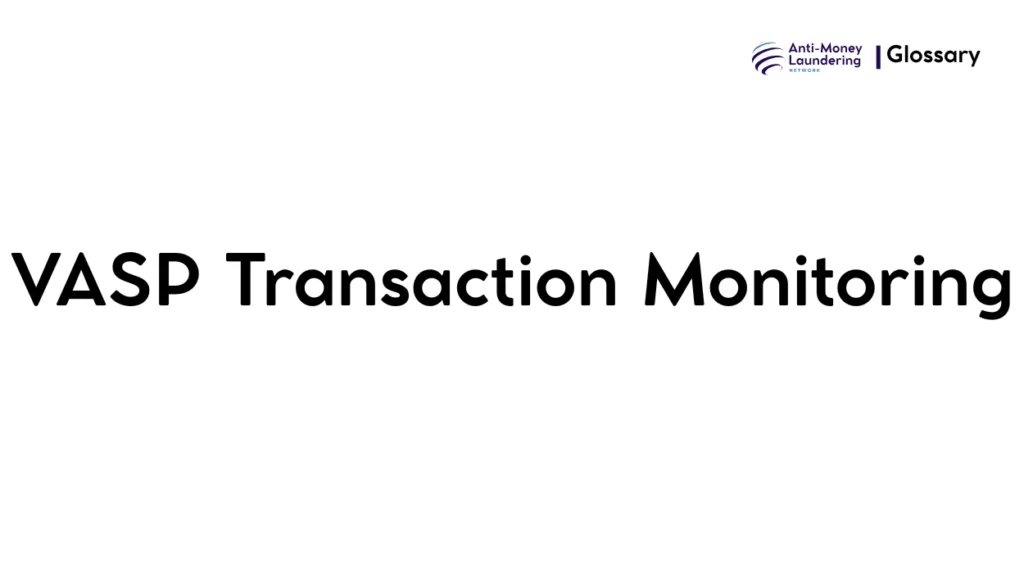Understanding “VASP transaction monitoring” is essential for financial institutions, compliance officers, and Virtual Asset Service Providers (VASPs) involved in the digital asset industry. This comprehensive explanation covers its definition, regulatory basis, practical applications, and challenges. The content is tailored to help you grasp the significance of transaction monitoring in preventing money laundering and terrorist financing through virtual assets.
Definition
VASP transaction monitoring refers to the continuous, systematic process by which Virtual Asset Service Providers (VASPs) observe, analyze, and verify transactions involving virtual assets. This monitoring aims to identify and flag suspicious activities that may indicate money laundering, terrorist financing, or other illicit financial behavior conducted via digital currencies or assets.
Purpose and Regulatory Basis
Role in AML
Transaction monitoring within VASPs serves to detect suspicious transaction patterns that deviate from a customer’s usual activity or from expected behaviors based on risk profiles. By catching these irregularities early, VASPs help prevent virtual assets from being exploited for illegal purposes.
Why It Matters
Given the pseudo-anonymity and cross-border nature of virtual assets, criminals may leverage them to launder proceeds of crime. Transaction monitoring safeguards the financial ecosystem, ensuring virtual assets do not become a conduit for illicit finance.
Key Global and National Regulations
- Financial Action Task Force (FATF) Recommendations: FATF Recommendation 15 extends AML/CFT obligations to VASPs, mandating the implementation of risk-based transaction monitoring akin to traditional finance sectors.
- USA PATRIOT Act: U.S. regulations incorporate VASPs within the definition of financial institutions requiring AML programs, including transaction monitoring.
- European Union AML Directive (AMLD): The EU’s AMLD5 and AMLD6 include specific provisions for VASPs, obliging them to monitor and report suspicious virtual asset transactions.
When and How It Applies
Real-World Use Cases
VASP transaction monitoring is triggered during any customer transaction involving virtual assets, such as:
- Converts between virtual assets and fiat currencies.
- Transfers between different virtual asset wallets or exchanges.
- Deposits or withdrawals involving virtual assets.
Triggers and Examples
Transactions may be scrutinized when:
- They involve unusually large amounts or rapid successive movements.
- Patterns deviate significantly from the customer’s normal behavior.
- Funds flow through jurisdictions flagged for high AML risks.
- Anonymity-seeking behavior is detected, such as frequent use of mixers or privacy coins.
Types or Variants of VASP Transaction Monitoring
- Manual Monitoring: Conducted by compliance teams reviewing flagged transactions based on periodic reports or alerts.
- Automated Rule-Based Monitoring: Systems apply predefined rules to detect anomalies, such as threshold breaches or pattern detection.
- Advanced AI-Driven Monitoring: Utilizes machine learning and blockchain analytics to detect complex laundering schemes and unknown suspicious behaviors.
Procedures and Implementation
Steps for Compliance
- Risk Assessment: Evaluate institutional and customer risk profiles to calibrate monitoring intensity.
- Customer Due Diligence (CDD): Baseline identity verification and ongoing profile updates.
- Transaction Screening: Real-time or batch monitoring against risk-based criteria.
- Alert Generation: System flags transactions deviating from expected profiles or matching suspicious patterns.
- Investigation: Compliance analysts review alerts to determine legitimacy.
- Reporting: Confirmed suspicious transactions are reported as Suspicious Transaction Reports (STRs) to authorities.
Systems and Controls
- Deploy transaction monitoring software capable of integrating blockchain data.
- Regularly update detection rules aligned with emerging typologies.
- Maintain audit trails and documentation for compliance verification.
Impact on Customers/Clients
Clients may experience:
- Additional verification processes or delays during suspicious transaction investigations.
- Restrictions or freezes on accounts pending review.
- Obligations to provide clarifying documentation when transactions are flagged.
While necessary for compliance, these measures should balance regulatory demands with customer experience.
Duration, Review, and Resolution
- Monitoring is continuous and ongoing as part of the VASP’s AML program.
- Alerts should be reviewed promptly—timeframes depend on institutional policies but must comply with regulatory expectations.
- Resolutions involve clearing false positives or initiating reports for confirmed suspicions.
- Periodic reviews of the monitoring system’s effectiveness should be conducted to adjust for new risks.
Reporting and Compliance Duties
- VASPs must maintain detailed records of transaction monitoring activities.
- Suspicious transactions must be reported to Financial Intelligence Units (FIUs) or equivalent authorities.
- Non-compliance can lead to significant penalties, including fines, sanctions, or business restrictions.
Related AML Terms
- Customer Due Diligence (CDD): The process of verifying customer identities as a prerequisite to monitoring.
- Suspicious Transaction Report (STR): Official notification submitted upon identifying suspicious activity.
- Know Your Customer (KYC): Policies ensuring accurate customer profiling.
- Travel Rule: A FATF requirement obliging VASPs to share customer and transaction information during transfers.
Challenges and Best Practices
Common Issues
- High false positive rates causing resource strain.
- Rapidly evolving laundering methods utilizing decentralized finance (DeFi).
- Integration challenges between blockchain data and traditional monitoring tools.
Addressing Them
- Implement risk-based approaches tailored to operational realities.
- Leverage AI and blockchain analytics for enhanced detection.
- Train compliance teams regularly on emerging typologies.
- Maintain transparent communication with customers about monitoring processes.
Recent Developments
- FATF’s updated guidance (2023–2024) on VASP obligations including DeFi protocols.
- Rising use of AI-powered monitoring tools that incorporate natural language processing and behavioral analytics.
- Increasing regulatory focus on sanctions evasion detecting through virtual assets.
VASP transaction monitoring is a cornerstone of effective AML compliance in the virtual asset sector. By actively observing virtual asset transactions through advanced and risk-based systems, VASPs play a critical role in detecting and preventing money laundering and terrorist financing. Maintaining robust monitoring programs aligned with international regulatory standards not only safeguards the financial system but enhances institutional reputation and customer trust.

